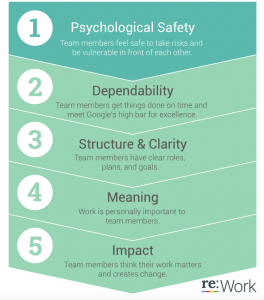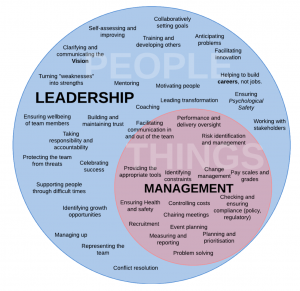A sudden adoption of remote working.
In early 2020, due to the Covid 19 outbreak, many organisations around the world went through a sudden digital transformation and many teams became remote. With this near-instant operational pivot to distributed and remote teams, organisations and the people within them encountered new and difficult challenges such as poor internet connectivity, inadequate home offices, and trying to manage simultaneous family and work life.
One of the biggest challenges is the impact of being physically distant from our teammates on our psychological wellbeing. Distributed teams have fewer opportunities for spontaneous, casual conversation; team members have more difficulty picking up non-verbal cues in conversation, and people are more likely to feel alone, anxious, unsure of what to do, and may even experience self-doubt or imposter syndrome.
Fundamental requirements for high performing teams

Psychological safety is the number one requirement for high performing teams. Without it, a team will never achieve high performance and the members of that team will not be able to realise their full potential. Now that many of our teams are distributed and remote, psychological safety is even more difficult to build and maintain.
Here are ten things you can do, whether you’re a leader or a member of your team, to help foster and build psychological safety, and increase the performance and happiness of your team and yourself.
Ten key actions to improve psychological safety in remote teams.
1. Set the stage.
We’re all going through difficult times, whether it’s financial concerns, supporting vulnerable friends and relatives or just dealing with the mental load of what’s happening in the world. Be honest about this with your team. Be explicit about the challenges ahead, and show your vulnerability. Without you showing vulnerability, your team will be unlikely to, and it’s a key part of building psychological safety. Be positive and enthusiastic about facing these challenges.

2. Make sure everyone knows what to do.
Knowing what to do, when to do it, and what good looks like is crucial for remote team members. It’s far more difficult to ask for advice or assistance when remote, and self-doubt will creep in quickly. So make sure team members know what is expected of them, and ensure that workloads and deliverables are realistic.
3. Focus on outcomes, not outputs.
Outcomes matter more than anything else. Whether your desired outcome is satisfied customers, revenue generated, uptime, or something else, focus on that, and ensure the team remain focussed on it. Resist the temptation to revert to more traditional, “lazy” styles of management by measuring outputs, lines of code written, story points completed or meetings attended. And certainly avoid falling back to input-driven management by logging hours worked – we already know that is a route to reduction of psychological safety and it’s the last thing a distributed team needs.
By keeping the team focussed on what really matters to the business, psychological safety will be improved, because team members will know that their hard work makes a difference, and they can contribute to the success of the organisation.

4. Build a culture of appreciation.
When we’re all in the same place, appreciation and thanks are much easier to communicate and tend to be passive or automatic. With distributed teams, much more effort needs to be made to ensure team members feel valued and appreciated. This means being much more explicit with appreciation, and communicating it in multiple ways such as through video calls, emails, and instant messaging. It’s very easy to forget how often we thank each other when we’re co-located, and without that culture of appreciation, psychological safety will suffer.
5. Embrace routine and ritual.
The dramatic shift in ways of working has resulted in disruption to our routines – our start and finish times, any regular meetings, and lunch breaks have all been disrupted. Routines help us as humans feel more comfortable and psychologically safe when the world around us is changing and there is so much uncertainty elsewhere.
Ritual also plays an important role in team cohesion, particularly so with distributed and remote teams. Every team will have its own rituals and ceremonies, from ringing a bell at a sprint kickoff, to having end-of-week drinks on a video call. Whatever the rituals are, keep them up in order to build psychological safety.

6. Establish work boundaries.
Work has invaded our homes and our personal space and time. It’s very easy to allow work to spread out, particularly if strict boundaries are not set. Help your team set these boundaries, and enforce and model them. This may be ensuring that team members can turn off their phones after 6pm without worrying about missing important messages, or purchasing home office equipment so they don’t need to work from their kitchen table.
To maintain psychological safety, team members need to be able to remove themselves from work and maintain their own personal, home and family space.
7. Use the many species of video call.
Video calls aren’t just for meetings. To bring back the feeling of cohesion and togetherness that is so important for psychological safety, try out different kinds of video call, such as “good morning” meetings to start the day, or by having an “always-on” watercooler style meeting where people can drop in and out as desired. Feeling more connected to team mates will build psychological safety and improve communication.
8. Be actively inclusive, or risk being passively exclusive.
In an office setting, it’s easy to see if someone is not engaged or is pulling away from the team. With a distributed team, this is far more difficult even on video calls.
A critical stage of psychological safety is “contributor safety” – everyone needs to contribute if the team is to achieve high performance, and in distributed and remote teams, if you’re not being actively inclusive, you’re risking being passively exclusive. To build psychological safety, invite participation, ask questions, and always ensure that everyone has spoken at least once before ending a meeting.
9. Adopt Hanlon’s razor.
First published in German in 1774, Johann Wolfgang von Goethe wrote in The Sorrows of Young Werther: “Misunderstandings and lethargy perhaps produce more wrong in the world than deceit and malice do. At least the latter two are certainly rarer.” A sentiment later attributed to Robert J. Hanlon, hence “Hanlon’s razor”.
That is to say, it is important to assume the best intentions. If an email or message comes across as rude, blunt, or offensive, assume it was a miscommunication or misunderstanding. If in doubt, ask for clarification, ideally via video or voice.
To avoid others falling into the same trap, embrace emojis and gifs in your communications, even if they’re not your usual style. Emojis and gifs can help build and maintain psychological safety by ensuring that your communication is received in the most positive way possible.

10. Put your own oxygen mask on first.
If you’re struggling with your own psychological safety, you will not be as effective in helping others with theirs. Find a mentor to advise and help you, eat healthily (but remember to treat yourself), exercise, meditate, and take time away from work; essentially, do whatever you know helps you maintain a happy and healthy approach and pace of work. As leaders of teams, many of us get so focused on caring for our team members that we minimise or neglect our own needs, but if you don’t look after yourself, you can’t look after others.
Take your time.
Finally, be patient. These are difficult times, and it’s to be expected that we will all experience challenges that impact our psychological safety and that of our team members. Utilising the ten behaviours above will help you and your team maintain psychological safety and improve not just team performance, but happiness too. Remember, happy teams aren’t happy because they’re high performing: they’re high performing because they’re happy.
Check out information about how to measure psychological safety in your teams here.
Download a complete Psychological Safety Action Pack full of workshops, tools, resources, and posters to help you measure, build, and maintain Psychological Safety in your teams.
For more information about building psychologically safe teams, read more about DevOps and psychological safety, read about high performing teams and psychological safety, or get in touch if you’d like me to speak or work with you.
